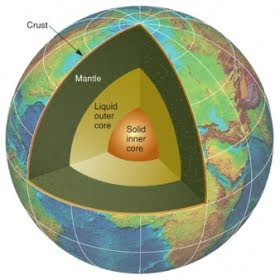Earth's solid inner core may be continually inching eastward relative to its liquid outer core, renewing itself by shedding its front while solidifying its back, a team of French scientists suggests.
"Within less than 100 million years, everything that has been crystallized on the west will have melted on the east," said lead researcher Thierry Alboussiere of Université Joseph Fourier in Grenoble.
The idea counters traditional theory that the big ball at the center of the Earth stands still, growing uniformly in all directions as the planet cools. It could shed light on the nature of the core — such as its age, apparent seismic mismatches, and a mysterious coating of dense fluid on its surface.
Seismic clues
About a billion years ago, the middle of the Earth began slowly solidifying from the inside out. The planet is hottest at its center, possibly even hotter than the surface of the sun, yet the core's iron is thought to be solid because of the extreme pressure that has raised its melting temperature. As it freezes, according to theory, the inner core takes in more iron, sending lighter elements up through the liquid outer core. This movement is thought to drive Earth's magnetic field.
Since scientists can't journey the roughly 4,000 miles (6,400 kilometers) to the center of the Earth to see what's going on, insight of the 1,600-mile (2,570-km) wide innermost layer more or less stops there. But bits and pieces of indirect information come in all the time, through earthquakes.
The study is detailed in the Aug. 4 edition of the journal Nature.

